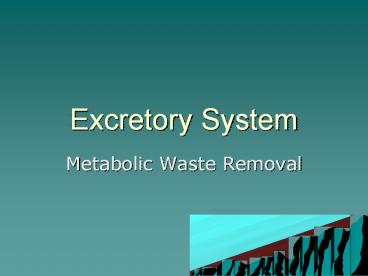Excretory System PowerPoint PPT Presentation
Title: Excretory System
1
Excretory System
- Metabolic Waste Removal
2
Organs of Excretory System
- Lungs CO2 and water
- Skin - Sweat
- Kidneys Urine
- Liver detoxification of blood
- These organs work with other body systems to keep
the body in homeostasis.
3
Excretion
- Excretion is the process by which waste and
excess substances are removed from the body. - If wastes from metabolism (metabolic wastes) are
not removed from the body, the body will die. - Metabolic wastes come from chemical reactions in
the cells of the human body
4
Major Metabolic Wastes
- Carbon Dioxide
- Nitrogen compounds
- Ammonia
- Urea
- Uric acid
- Mineral Salts
- Sodium chloride
- Potassium sulfate
- All of these wastes are poisonous to the body in
high concentrations
5
Nitrogen wastes
- Nitrogen wastes are a by product of protein
metabolism. - Amino groups are turned into ammonia, which in
turn is converted to urea, dumped into the blood
and filtered out by the kidneys. - Ammonia is converted to urea, a compound the body
can tolerate at higher concentrations than
ammonia.
6
Role of the Liver
- Removes harmful substances such as bacteria,
certain drugs, and nitrogenous wastes from the
blood - In the liver the substances are changed into
inactive or less poisonous forms - Inactive substances (urea) are returned to the
blood stream and filtered and excreted by the
kidneys.
7
The Skin
- The skin performs a number of different functions
one of them is excretion of wastes. - In sweat there is a small amount of urea and
salts. - Sweat 99 water 1 Urea and Salts
8
Lungs
- Excrete CO2 and Water
- The end products of cellular respiration
9
Urinary System
- Waste is filtered from the blood and collected as
urine in each kidney. - Urine leaves the kidneys by ureters, and collects
in the bladder. - The bladder can distend to store urine that
eventually leaves through the urethra - The urinary system
- Kidneys
- Ureters
- Bladder
- urethra
10
Urinary tract
Kidneys
Ureters
Bladder
Urethra
Prostate
Male
Female
11
Kidneys
- Bean shaped organs that are about 10cm long
- Main Functions
- Remove wastes of cellular metabolism (metabolic
waste) - Regulate the concentrations of the substances in
the blood
12
Kidneys (1)
13
Kidneys (2)
14
Structure of the Kidneys
- Kidney is made up of 3 parts
- Cortex outer part
- Medulla middle part
- Pelvis inner part
- Blood is filtered in the cortex
- Collecting ducts extend through the medulla
- The filtered substances, called the filtrate,
collect in the pelvis which are connected to the
ureter
15
Cross Section of Kidney
16
Nephrons
- MOST important job of the kidney is to filter
waste from blood - The filtering is done by the nephron.
- There are about 1.25 million nephrons in each
kidney
17
(No Transcript)
18
Components of The Nephron
- Glomerulus Arteriole blood is filtered under
high pressure. - Bowman's Capsule surrounds the glomerulus and
collects the filtrate
19
Bowman capsule
20
Component of Nephrons Continued
- Proximal Convoluted Tubule
- Loop of Henle
- Distal Convoluted Tubule
- All of these nephron structures aid in the
reabsorption of materials needed for the body.
21
(No Transcript)
22
Nephron (1)
23
The Nephron Function
- The nephron consists of a ball of blood
capillaries called the glomerulus - Blood flows into the kidney through the renal
artery, which branches into capillaries
associated with the glomerulus.
24
The Nephron Function Continued
- Arterial pressure causes water and solutes from
the blood to filter into the Bowmans Capsule
which surrounds the glomerulus - The Filtrate flows through the proximal
convoluted tubule, loop of Henle, and then into
the distal convoluted tubule. - The distal tubule empties into a collecting duct.
Which carries urine to the pelvis of the Kidney
25
(No Transcript)
26
The nephron has three functions
- Glomerular filtration of water and solutes from
the blood. - Tubular reabsorption of water and conserved
molecules back into the blood. - Excretion of urine from collecting tubes
27
WOW thats a big filter
- Nephrons filter 125 ml of body fluid per minute
filtering the entire body fluid component 16
times each day. - In a 24 hour period nephrons produce 180 liters
of filtrate, of which 178.5 (99) liters are
reabsorbed. - The remaining 1.5 liters forms urine.
28
Disruption of Kidney Function
- Infection, environmental toxins such as mercury,
and genetic disease can have devastating results
by causing disruption of kidney function. Many
kidney problems can be treated by dialysis, where
a machine acts as a kidney. Kidney transplants
are an alternative to dialysis.

